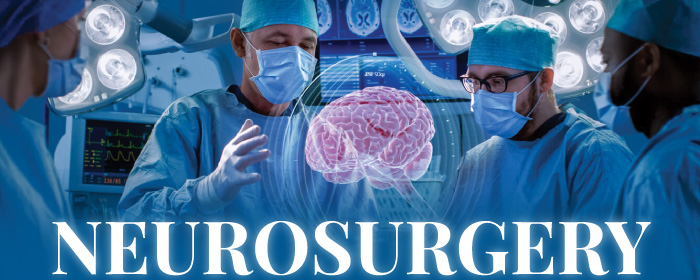Neuroscience

Who are Neurosurgeons? What do they do?
Neurosurgeons are specialized doctors in neurology who diagnose and treat problems related to the nervous system. They specialized in treating conditions like tumours on the brain symptoms, aneurysms, traumatic brain injuries, brain stroke, brain cancer, spinal cord injuries, congenital anomalies, and degenerative spine disorders. Following are some brief explanations of the subspecialties of neurosurgery.
Spine surgery: Neurosurgeons perform spine surgery to treat conditions that affect the spine & the spinal cord, such as herniated discs, spinal stenosis, and spinal tumours.
Pediatric neurosurgery: Neurosurgeons who specialise in pediatric neurosurgery treat neurology conditions in children, including congenital malformations, hydrocephalus, and brain tumours.
Brain tumour surgery: Neurosurgeons remove brain tumours to relieve brain pressure and prevent cancer spread.
Cerebrovascular neurosurgery: Neurosurgeons perform cerebrovascular neurosurgery to treat conditions that cause the blood vessels in the brain and spinal cord, such as aneurysms, arteriovenous malformations, and strokes.
Functional neurosurgery: Neurosurgeons use functional neurosurgery to treat movement disorders, such as Parkinson’s disease, by implanting devices that stimulate or regulate the brain.
Epilepsy surgery: Neurosurgeons perform epilepsy surgery to remove or disconnect the part of the brain that causes seizures.
Skull base surgery: Neurosurgeons use skull base surgery to remove tumours and treat other conditions affecting the skull base and surrounding areas.
Minimal access neurosurgery: Neurosurgeons perform minimal access neurosurgery using small incisions and specialised instruments to minimise damage to surrounding tissue and speed up recovery.
Endoscopic neurosurgery: Neurosurgeons use endoscopic neurosurgery to treat conditions that affect the brain and the skull base using a minimally invasive approach.
Endovascular neurosurgery: Neurosurgeons use endovascular neurosurgery to treat conditions that cause the blood vessels in the brain to use catheters and other specialised instruments.
Peripheral nerve surgery: Neurosurgeons perform peripheral nerve surgery to treat conditions that affect the nerves outside the brain & spinal cord, such as carpal tunnel syndrome and nerve injuries.
Hence, Neurosurgeons are experts in performing a wide range of brain, spine, and peripheral nerve surgeries.
Spine, Brain and Peripheral Nerve Surgeries
Let’s dive deep into the spine, brain and peripheral nerve surgeries that Neurosurgeons perform.
SPINE SURGERIES:
Lumbar disc surgery: A surgical procedure to remove a damaged disc in the lower back to relieve pressure on nerves and reduce pain.
Laminectomy: A surgical procedure to remove a part of the bone (lamina) covering the spinal cord to relieve pressure on nerves affected by spinal stenosis.
Spinal stabilisation and fusion: A surgical procedure to join two or more vertebrae to provide stability and reduce pain caused by spinal instability or deformity.
Spinal tumour excision: A surgical procedure to remove a tumour in the spinal cord or surrounding tissues to relieve pressure on the spinal cord and reduce neurological symptoms.
Lumbar discectomy: A surgical procedure to remove a part or the entire damaged disc in the lower back to relieve pressure on nerves and reduce pain.
Nerve root block: A minimally invasive procedure to relieve pain and inflammation in the nerve roots by injecting medication directly into the affected nerve.
Anterior cervical discectomy & fusion: It is a surgical procedure to detach a damaged disc in the neck through a small incision in the front of the neck and join two or more vertebrae to provide stability.
Cervical laminoforaminotomy: A surgical procedure is performed to relieve pressure on the spinal nerves in the neck by removing a small portion of the bone overlying the affected nerve.
C1-C2 fixation: A surgical procedure to stabilise the top two vertebrae in the neck to treat instability, spinal cord compression or other conditions.
Occipito-cervical fusion: A surgical procedure to join the base of the skull and the upper part of the neck to provide stability and reduce pain caused by deformity or instability.
BRAIN SURGERIES:
Ventriculoperitoneal shunt: A surgical procedure to insert a shunt that removes excess cerebrospinal fluid from the brain to the abdomen to treat hydrocephalus.
Theco-peritoneal shunt: A surgical procedure to insert a shunt that drains cerebrospinal fluid from the lower back to the abdomen to treat hydrocephalus.
ETV: Endoscopic Third Ventriculostomy, a surgical procedure to create a small hole in the floor of the 3rd ventricle to allow cerebrospinal fluid to flow and relieve pressure on the brain in select cases of hydrocephalus.
Decompressive craniectomy: A surgical procedure to relieve pressure on the brain in severe traumatic brain injury or stroke cases. During the process, a portion of the skull is removed to allow the brain to expand without being compressed against the skull. It helps to reduce the
pressure inside the skull and prevent further damage to the brain. After the swelling has subsided, the skull piece is replaced, or an artificial replacement is used to restore the shape of the skull.
Cranioplasty: A surgical procedure to repair or reconstruct the skull after injury or surgery.
Craniotomy: A surgical procedure that involves opening the skull to access the brain.
Burrhole and evacuation of SDH: A surgical procedure to make a small hole in the skull and remove a subdural hematoma, a collection of blood between the brain & its outermost covering.
Craniotomy and tumour excision: A surgical procedure to remove a brain tumour through an opening in the skull.
Minimally invasive (Endoscopic) hematoma evacuation: A surgical procedure where the blood clot inside the brain is removed using an endoscope, using a small incision.
Epilepsy surgery: A surgical procedure to remove the brain area responsible for epileptic seizures in patients who do not respond to medications.
DBS (Deep Brain Stimulation) for Parkinson’s disease: A surgical procedure to implant a device that delivers electrical stimulation to the brain to reduce the symptoms of Parkinson’s disease.
Endoscopic-Trans nasal surgery for pituitary tumour: A minimally invasive surgical procedure to remove a pituitary tumour through the nose using an endoscope.
Brain bypass surgery: A surgical procedure to reroute blood flow around a blockage in the brain to prevent stroke or other neurological damage.
Aneurysm clipping: A surgical procedure to clip off an aneurysm to prevent it from rupturing and causing bleeding in the brain.
Aneurysm coiling: A minimally invasive procedure to insert a coil into an aneurysm to prevent it from rupturing.
Endovascular treatments of brain aneurysms: Minimally invasive techniques to treat brain aneurysms, such as coiling, stenting & flow diverter.
DSA of the brain: Digital subtraction angiography (DSA) is an imaging process that uses X-rays and contrast dye to visualise blood vessels in the brain and diagnose various neurological conditions.
Mechanical thrombectomy: A minimally invasive process to remove a blood clot in the brain using specialised catheters and devices.
Carotid endarterectomy: A surgical procedure to eliminate plaque buildup from the carotid arteries to reduce the risk of stroke.
Brain AVM excision: A surgical procedure to remove an arteriovenous malformation (AVM) in the brain to prevent bleeding and neurological damage.
Brain AVM embolisation: A minimally invasive procedure to block the blood flow to an AVM in the brain using an embolic material.
Embolisation of middle meningeal artery: A minimally invasive process to block the blood flow to the middle meningeal artery, a common source of bleeding in the brain.
PERIPHERAL NERVE SURGERIES:
Brachial plexus repair: A surgical procedure to repair or reconstruct the nerve network that controls movement & sensation in the shoulder, arm, and hand.
Carpal tunnel release surgery: A surgical procedure to eliminate pressure on the median nerve in the wrist by cutting the ligament to form the roof of the carpal tunnel.
Peripheral nerve biopsy: A diagnostic procedure to remove a small sample of nerve tissue to examine under a microscope to diagnose various neurological conditions.
At Siu-Ka-Pha Multispeciality Hospital, we pride ourselves on staying at the forefront of neurosurgeries. Our state-of-the-art facilities enable us to perform modern adjuncts in neurosurgery, including Neuronavigation,
Neuro-Endoscopy, Intra-operative ultrasound, Neuromonitoring, and Minimally invasive approaches to the brain and spine. These advanced techniques and technologies enhance our surgical procedures’ precision, safety, and effectiveness, ultimately benefiting our patients’ outcomes.
Siu-Ka-Pha Multispeciality Hospital is committed to providing exceptional care to our patients in neurosurgery. Our dedicated team, advanced facilities, and commitment to patient safety make us a reliable choice for comprehensive neurosurgical treatments. Contact us to schedule a consultation and receive personalised care tailored to your needs.






















 Call Us
Call Us Book Appiontment
Book Appiontment